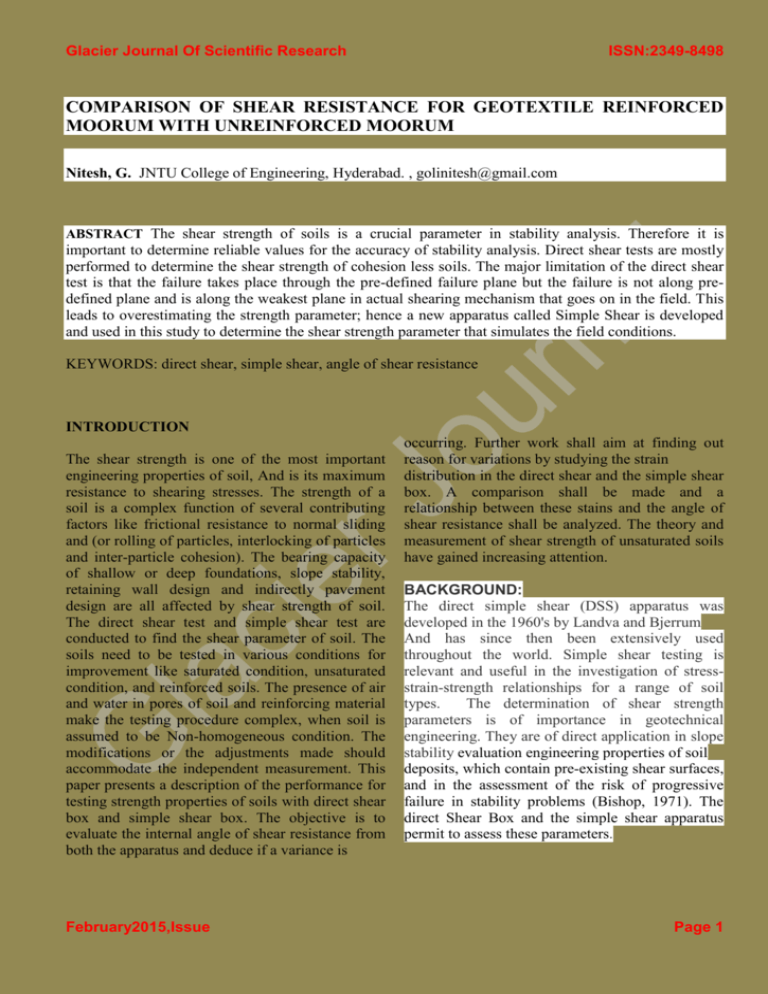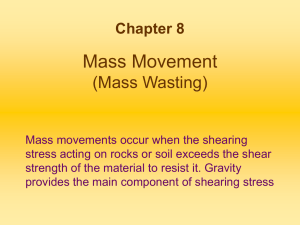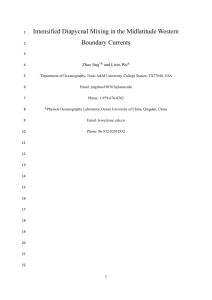- Glacier Journal
advertisement

Glacier Journal Of Scientific Research ISSN:2349-8498 COMPARISON OF SHEAR RESISTANCE FOR GEOTEXTILE REINFORCED MOORUM WITH UNREINFORCED MOORUM Nitesh, G. JNTU College of Engineering, Hyderabad. , golinitesh@gmail.com ABSTRACT The shear strength of soils is a crucial parameter in stability analysis. Therefore it is important to determine reliable values for the accuracy of stability analysis. Direct shear tests are mostly performed to determine the shear strength of cohesion less soils. The major limitation of the direct shear test is that the failure takes place through the pre-defined failure plane but the failure is not along predefined plane and is along the weakest plane in actual shearing mechanism that goes on in the field. This leads to overestimating the strength parameter; hence a new apparatus called Simple Shear is developed and used in this study to determine the shear strength parameter that simulates the field conditions. KEYWORDS: direct shear, simple shear, angle of shear resistance INTRODUCTION The shear strength is one of the most important engineering properties of soil, And is its maximum resistance to shearing stresses. The strength of a soil is a complex function of several contributing factors like frictional resistance to normal sliding and (or rolling of particles, interlocking of particles and inter-particle cohesion). The bearing capacity of shallow or deep foundations, slope stability, retaining wall design and indirectly pavement design are all affected by shear strength of soil. The direct shear test and simple shear test are conducted to find the shear parameter of soil. The soils need to be tested in various conditions for improvement like saturated condition, unsaturated condition, and reinforced soils. The presence of air and water in pores of soil and reinforcing material make the testing procedure complex, when soil is assumed to be Non-homogeneous condition. The modifications or the adjustments made should accommodate the independent measurement. This paper presents a description of the performance for testing strength properties of soils with direct shear box and simple shear box. The objective is to evaluate the internal angle of shear resistance from both the apparatus and deduce if a variance is February2015,Issue occurring. Further work shall aim at finding out reason for variations by studying the strain distribution in the direct shear and the simple shear box. A comparison shall be made and a relationship between these stains and the angle of shear resistance shall be analyzed. The theory and measurement of shear strength of unsaturated soils have gained increasing attention. BACKGROUND: The direct simple shear (DSS) apparatus was developed in the 1960's by Landva and Bjerrum And has since then been extensively used throughout the world. Simple shear testing is relevant and useful in the investigation of stressstrain-strength relationships for a range of soil types. The determination of shear strength parameters is of importance in geotechnical engineering. They are of direct application in slope stability evaluation engineering properties of soil deposits, which contain pre-existing shear surfaces, and in the assessment of the risk of progressive failure in stability problems (Bishop, 1971). The direct Shear Box and the simple shear apparatus permit to assess these parameters. Page 1 METHODOLOGY: DST: To study the shearing mechanism and the strength parameter, there is specimen considering container or shear box which is separated by horizontally into two halves. One half is fixed with respect to that half is either pushed (or) pulled horizontally. A normal load is applied to soil specimen in the shear box through a rigid loading cap. The shear load, horizontal deformation and vertical deformation are measured during the test. Dividing the shear force and normal force by nominal area of specimen, we obtain shear stress as well as normal stress on failure plain. The failure plain is forced to horizontal with the apparatus. apparatus has been modified by reducing the thickness and of increasing the number of plates. Simple shear apparatus Direct shear apparatus SST: A new simple shear apparatus was developed to provide the solution to all the above discussed problems. This is simple box consists of 8 plates that can slide over each other, four rods that constrain the motion of these plates to desired extent. Simple shear box is more suitable for evaluating ground response which gives a fairly good and accurate estimate of strength parameters. The main mechanism is derived from direct shear box and focuses on the shearing. In direct shear an assumption of expecting the same behavior in insitu as in lab. To stimulate the field conditions, this TESTING: The soils samples were tested in both the apparatus at different normal stresses i.e. at 24.52, 49.04, and 99.07 kPa. The samples along were mounted on the shearing apparatus and were tested for their shear strength characteristic at different levels of normal stresses. The apparatus had two dial gauges. One measured the vertical displacements with a least count of 0.01mm and the other measured the horizontal displacements with a least count of 0.01 mm. Thus the shear stress and vertical displacement corresponding to the horizontal displacement were measured. During the testing the following parameter was also measured and recorded in an output files with various relative densities, Fig1(a) and Fig(b) shows the comparison of varying of angle of shearing resistance for sand in direct shear test and simple shear test for various relative densities. . Fig: Top view of simple shear box 60 mm x 60 mm 21 mm 3mm Fig 1(a): Simple shear box before test Fig 1(b): Simple shear box after the test. 13.5 DW 12.04 WF DWW FQ 10.7 FFQC C32 4 32MMM DW MSASAC WF CMMMM FQC NNmNN 32M mmm mm MS 33 mm AC 33 MM NN mm mm 33 9.75 DW 8.17WF DW FQ 6.45 WF C32 DW 5.55WF FQ MM DW FQ C32 SAC 4.23WF C32 MM MM DW FQ MM SACNN WF C32 SACMM mm FQ MM MM NN mm mm 33 Fig C32 1(c):SAC Horizontal displacement of slices. NN mm are in mm) MMdimensions MM (All mm SACNN mm 33 MM mm 33 NN mm mm 33 mm 33 ANALYSIS OF DISCUSSIONS: RESULTS AND 120 Shear stress, τ, kPa 90 Direct shear test Direct simple shear test 60 30 0 0 20 40 60 80 100 Normal stress, σ, kPa Fig: 2 Shear stress Vs Horizontal Movement for unreinforced moorum-ID=35 %, Direct shear test Fig: 4 Shear stress Vs Horizontal Movement for unreinforced moorum-ID=35 %, Simple shear test . Fig: 3 Vertical Movement Vs Horizontal Movement for unreinforced moorum-ID=35 %, Direct shear test. Fig: 5 Vertical Movement Vs Horizontal Movement for unreinforced moorum-ID=35 %, Simple shear test Fig: 6 Shear stress Vs Horizontal Movement for Transversely reinforced moorum-ID=35 %, Direct shear test Fig: 8 Shear stress Vs Horizontal Movement for Transversely reinforced moorum-ID=35 %, Simple shear test Fig: 7 Vertical Movement Vs Horizontal Movement for Transversely reinforced sand-ID=35 %, Direct shear test. Fig: 9 Vertical Movement Vs Horizontal Movement for Transversely reinforced sandFig: 5 Vertical Movement Vs Horizontal ID=35 %, Simple shear test. Movement for unreinforced sand-ID=35 %, Simple shear test. Fig: 10 Shear stress Vs Horizontal Movement for Obliquely reinforced moorum-ID=35 %, Direct shear test Fig: 12 Shear stress Vs Horizontal Movement for Obliquely reinforced moorum-ID=35 %, Simple shear test Fig: 11 Vertical Movement Vs Horizontal Movement for obliquely reinforced sand-ID=35 %, Direct shear test. Fig: 13 Vertical Movement Vs Horizontal Movement for Obliquely reinforced sand-ID=35 %, Simple shear test. Angle of shearing resistance for unreinforced and reinforced moorum . DIRECT SHEAR TEST ID, % 35 UR, ( 0) 41.6 TR, ( 0) 50.3 OR, ( 0) 53.1 shear test the whole sample is getting sheared. The reason for this is because of fact that we are shearing the sample in pre-defined failure plane of failure. This is not case with simple shear test. The failure surface in direct shear box is pre-defined and soil is not allowed to fall in any other planes, where as in simple shear test failure surface is not defined and soil will fail in the plane of weakness. From results it can be concluded that direct shear test will overestimate the strength parameters. The actual mechanism of failure of a soil mass in shear is somewhat closer to mechanism of simple shear test and results achieved from simple sear test are more accurate and more relevant to the actual failure of soil mass in shear. Thus, it can be concluded that simple shear test gives a better estimate of strength parameters than direct shear test. REFERENCES: SIMPLE SHEAR TEST ID, % 35 UR, ( 0) 38.6 TR, ( 0) 45 OR, ( 0) 50.2 UR- UNREINFORCED TR- TRANSVERSELY REINFORCED 0R- OBLIQUELY REINFORCED CONCLUSIONS: The simple shear test shows the reduction in shear strength of soil as compared to the direct shear test. This can be reason because in direct shear test the whole sample is not sheared. As, in the simple 1) ASTM D 2487.2000 standard classification of soils for engineering purpose (Unified soil classification system). 2) DIN 18137-3.2002 soil, investigation and testing-determination of shear strength. 3) BORIN, D.L. 1973” the behavior of saturated kaolin in shear strength apparatus’, PhD. Thesis, University of Cambridge, England. 4) JOHN, N.C 1995 “Soil Mechanics” Shear strength, John Wiley and sons, Inc. 5) KRAMER, U. and RIZKALLAH, V. 1976. Experiences with determination of shear parameters in shear box device. 6) KHAN, I.H. 2005 “Geotechnical Engineering” “The shear strength of soils” “Prentice hall of India Pvt. Ltd.” 7) SAXENA, K.R. and SHARMA, U.M. 2003. “In-situ characterization of soils”, Taylor Francis (UK), Technology and industry arts. 8) VONSOOS, P.2001 “Properties of soils determination in the laboratory.”






